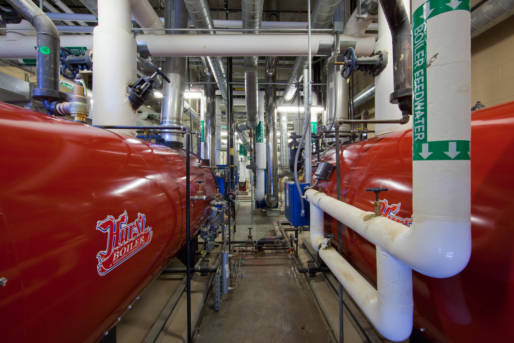Energy Savings for Today’s Healthcare Environment
posted April 22nd, 2019 in Design
by Nan Schramm
#sustainabledesign
Share

Hospitals require a large amount of energy to support daily operations on a 24/7 basis. Daily operations include critical systems and medical equipment, as well as supporting the patient experience. Previously, when a hospital attempted to reduce energy consumption, they would focus on back of house spaces. For example, changing out T12 Fluorescent fixtures to T8’s and adding motion sensors to less frequently used spaces. At the time, these small changes were at the forefront of achieving energy savings. Facility managers and designers have been collaborating on new, innovative strategies and tactics to help reduce consumption. Fortunately for the industry, technology has provided several tools.
Energy Saving Tools
In today’s market, facilities can adopt programs such as EnergyStar Portfolio Manager which provides healthcare facilities tools with which to benchmark their energy score against that of their peers. Energy Star Portfolio Manager considers a facility’s climate, weather, and the business activities at the facility. Building activities, such as MRI use, can be significant drivers of energy consumption. General, critical access, and children’s hospitals are eligible to participate. A hospital’s EnergyStar score (a 1 to 100 percentile ranking) is a framework by which a facility can compare its energy use intensity (EUI) to the national averages and that of their peers. By benchmarking energy use, and even greenhouse gas emissions, hospitals are given a tool to understand inefficiencies and a viable set of strategies to address those inefficiencies.

Another great resource is, Practice Greenhealth, an organization whose mission is “to transform healthcare worldwide so that its environmental footprint, becomes a community anchor for sustainability and a leader in the global movement for environmental health and justice”. It is the nation’s leading membership and networking organization for healthcare organizations who have pledged a commitment to sustainability and environmentally preferable practices. Practice Greenhealth provides tools for healthcare facilities to eliminate inefficient energy use while enhancing patient outcomes and minimizing costs. They believe that new initiatives such as The Department of Energy’s, Better Buildings Solutions Center, can help hospitals to identify viable, cost-effective strategies to reduce energy use.

https://practicegreenhealth.org/topics/leaner-energy
Retrofitting Lighting
Retrofitting with LED lighting can contribute to a reduction in hospital energy costs. According to the Department of Energy (D.O.E.), lighting accounts for 10% of a typical hospital’s electrical energy consumption. Now, with LED lighting retrofits or redesigns, the Department of Energy estimates that a 100-bed facility can realize $20,000 per year for operating expenses. In addition to cost savings, a facility’s carbon footprint is reduced, and less load is placed on generating facilities and backup power generating facilities.
Further savings can be achieved by substantially cutting back on lighting usage in special purpose rooms (under-used class rooms, lounges, and cafeterias). Facility operators can curtail lighting and plug loads without interrupting routine operations.
Retro-commissioning
Architects and Engineers can also contribute to energy savings for our clients through retro-commissioning. A process for recalibrating older building systems to help energy costs and improve operations, retro-commissioning often includes upgrading lighting to more energy efficient lamps and controls, and right sizing heating and cooling systems with upgrades or retrofits. Making these retrofits often comes with added benefits of noise reduction and lower maintenance costs.
Self-sufficiency
While not common, some hospitals are going off grid and producing their own energy for self- sufficiency. Sharp Grossmont Hospital in San Diego, CA is now officially off the grid having built their own central energy plant using cogeneration. Cogeneration utilizes combustion turbine generator (CTG). The CTG is powered by natural gas and has the ability to produce more energy than the hospital can use allowing for future growth. The new system also reduces the hospitals greenhouse emissions by 90%.
Eco-Charette
E4H utilizes an “Eco-Charrette” process at the beginning of a project, which builds consensus among the project team (designers, contractors, building users, owners, etc.) to focus on both the big picture as well as the details, thus arriving at an agreement on specific goals, strategies and project priorities relative to energy efficiency and sustainable design. This continual process of verifying quality systems and strategies provides for ready integration into a high-performance building project.

About Nan Schramm
WELL AP, LEED GA, EDAC, Fitwel Amb, Associate Principal